Split (Croatia) – the most detailed information about the city with photos. The main attractions of Split with a description, guides and cards.
Contents
City of Split (Croatia)
Split is a city in southern Croatia in the historic region of Dalmatia. Located in the central part of the Adriatic Sea and is the center popular resort region. Split is one of the oldest cities countries and the second most populous after Zagreb. He was built around the antique palace of the roman emperor Diocletian, who tried to find peace on the warm shores of the Adriatic after renunciation of the throne. Split attractions are included in a list of UNESCO World Heritage sites, and in the old town You can still see the remains of the Roman walls, squares and temples.
Split is a bright port city, which is considered the capital of Dalmatia. The residents themselves call it “the most beautiful city in the world” and “Mediterranean flower”. It is located in a stunning bay between mountains and the Adriatic Sea. The city was inhabited throughout 1700 years old. Here lived the Romans, Croats, Hungarians, Venetians and Austrians, so it boasts a diverse architecture and rich cultural heritage. Split has a whole the attractiveness and richness of the modern Mediterranean city, but lives in a slow rhythm, which is very easy get used to.
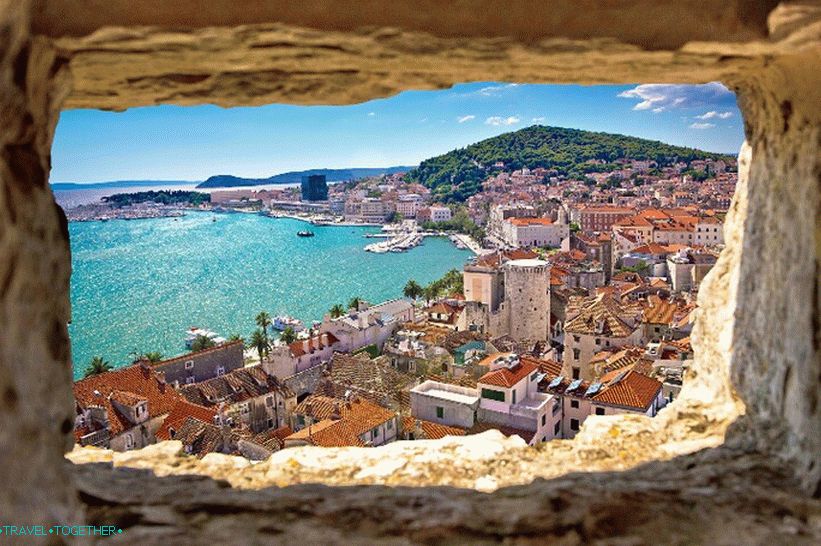 Panorama of the city
Panorama of the city
- Geography and climate
- Best time to visit
- Practical information
- Story
- How to get there
- Shopping and shopping
- Food and drink
- sights
- Video
- Maps and guides
- Comments and reviews
Geography and climate
Split is located in the central part of Dalmatia in southern Croatia the foot of Marjan Hill. The city is located on the peninsula of the same name and surrounded by the islands of Brac, Hvar, Solta and Ciovo. Climate – warm subtropical. Summers are hot and dry, winters are mild and wet. The holiday season lasts from May to October.
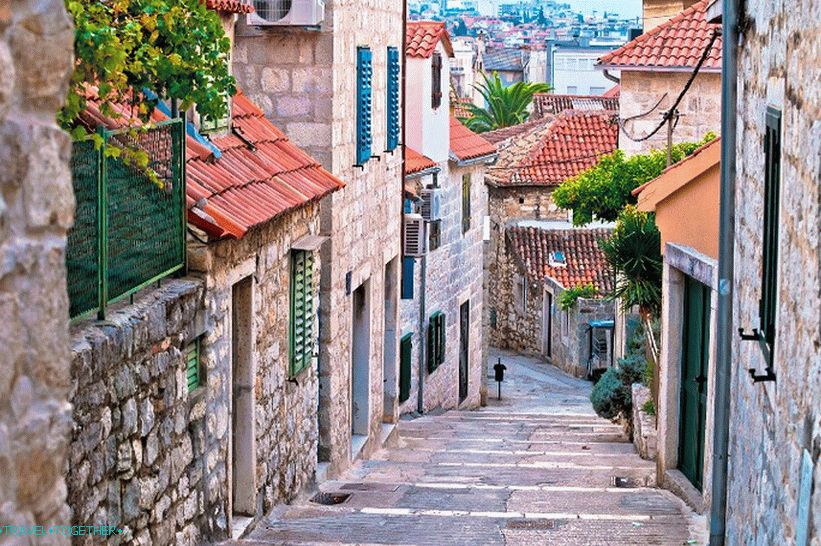 Streets of Split
Streets of Split
Best time to visit
If the main goal of a beach holiday is the period from May to October. For exploring the city and its attractions is fine off season (spring – autumn).
Practical information
- The population is 178 thousand people.
- Area – 79 square kilometers.
- The language is Croatian.
- Currency – Kuna.
- Visa – Schengen.
- Time – Central European UTC +1, in summer +2.
 Adriatic Sea in Split
Adriatic Sea in Split
Split Beaches
Split is a famous resort. Most popular beaches: Bačvice (sandy), Žnjan (pebbled), Kaštelet (sandy), Kašjuni (pebble), Bene (pebble), Trstenik (pebble), Firule (sandy) and Ovčice (pebble).
Bačvice is the most famous beach in Split. Here is the sea clean and shallow, and the bottom is even and sandy. Very popular place for family holidays. Ovčice – pebble beach located near Bačvice. Also nearby is a small sandy Firule beach.
If you need privacy, it is better to go to the beaches of the north side of the hill Marjan or visit the beaches of Hvar island or Brac.
Story
In the period of the Roman Empire on the territory of modern Split was the Roman province of Salona. The remains of the Roman city can look in the northwestern part of the historic center. Believed that in the 3rd century AD the future Roman emperor was born here Diocletian, who organized several reforms and brutally persecuted Christians. After the abdication of power, he settled in specially built palace and was buried here.
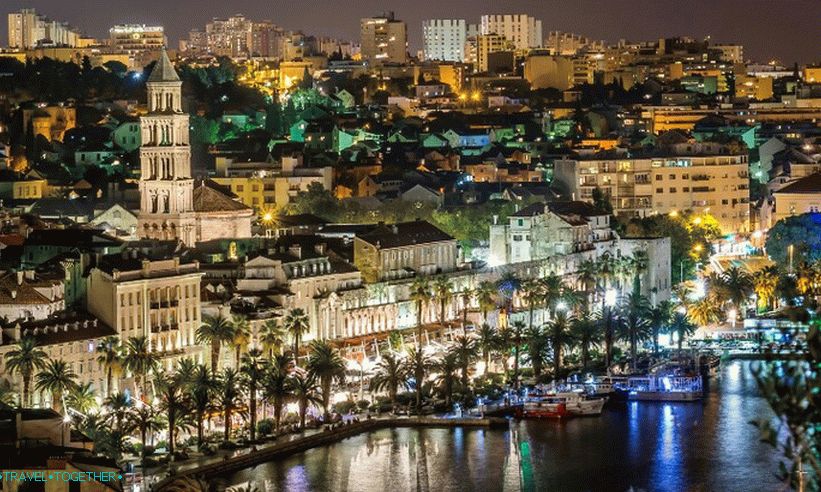 Night Split
Night Split
The city developed around the palace of Diocletian. In the 7th century Salon was destroyed by avars. At the end of this century on the territory of Dalmatia Slavs came. In the 12th century, Split recognized the power of the Hungarian king, while maintaining de facto independence until the beginning of the 15th century. AT 1420 almost all of Dalmatia began to belong to Venice. Under Venetians power Split became one of the most important shopping centers Adriatic. At the end of the 18th century, Dalmatia was conquered Austria. Split belonged to the Habsburg before the First world war.
During the First World War, Dalmatia was occupied by Italy. After the war, Split became part of Yugoslavia. In 1991 here there were several armed clashes between Croats and parts of the Yugoslav army that did not cause significant harm historical center.
How to get there
Split Airport is located 25 km west of the city center and is one of the largest in Croatia. He binds him to most European capitals and major cities. Many flights are seasonal. You can get to the city center from the airport by bus.
The railway station is located almost in the center of Split. Although the popularity of trains is small, as the number of proposed directions. Bus service is available with Zagreb, Dubrovnik, Rijeka, Sarajevo, Trieste and some cities in Austria and Germany. Three times a week there is a ferry from Split to Ancona and Pescara.
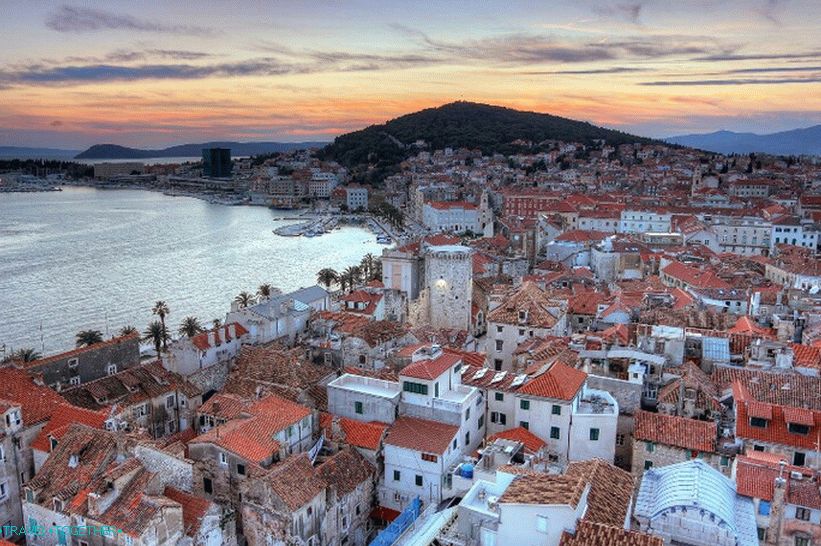 Panorama cities
Panorama cities
Shopping and shopping
Lots of stores are concentrated along the main trade. Split – Marmont street.
Food and drink
Dalmatian cuisine is a mixture of Croatian cuisine with strong influenced by Mediterranean (Italian) cuisine. One of the most Famous dishes of Split and Dalmatia is a steamer (vegetable pie). A very large number of dishes is built on fish and seafood. Popular food is risotto, dalmatian pašticada s njokama (gnochchi), prshut (ham), cevapi (grilled meat sausages). Dalmatia is also known for its world-class wines. In Split recommend trying local drinks called Pipi and Orela.
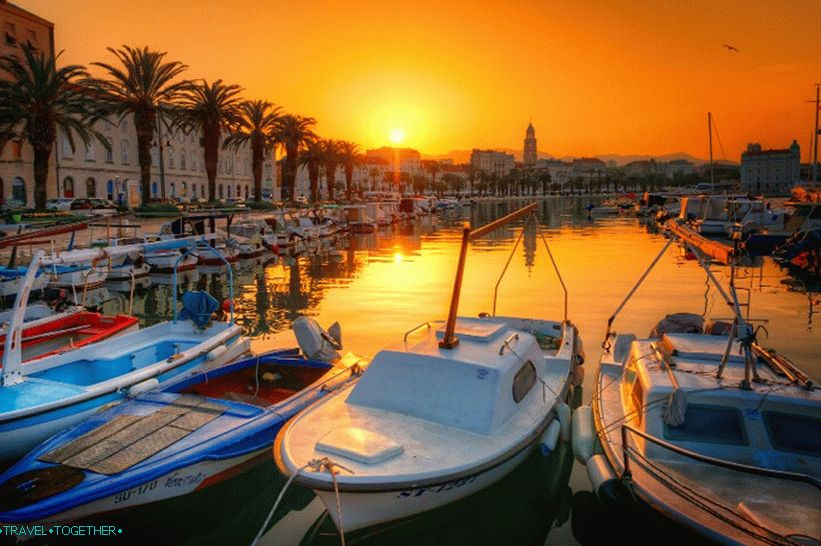 Split at sunset
Split at sunset
sights
Diocletian’s Palace is the main attraction of Split and real city symbol. Is one of the best surviving ancient buildings of this type in Europe. Palace was built for the roman emperor Diocletian in 305 AD. After the abdication of power, the former emperor lived here for 8 years until his death. Together with the historical center of Split is a UNESCO World Heritage Site.
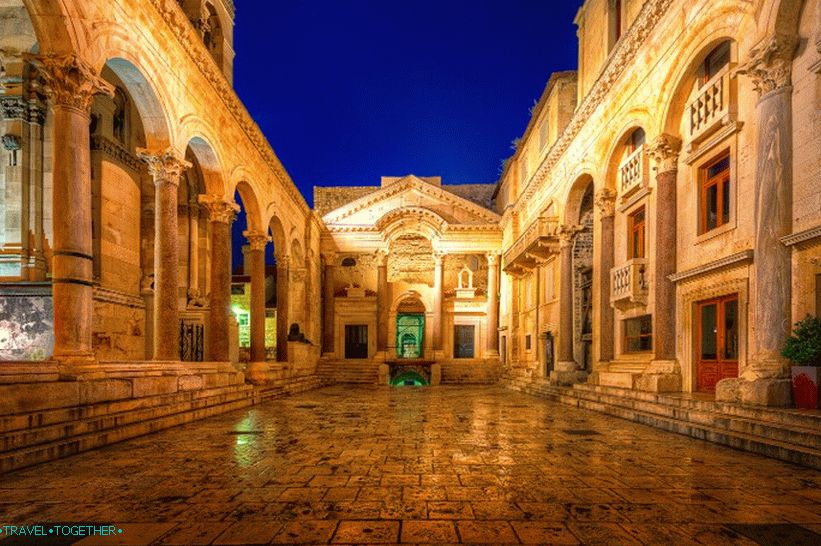 Diocletian’s Palace
Diocletian’s Palace
In fact, the entire historical center of Split was built around this ancient structure. The palace has a rectangular shape, length which is 190 meters wide and about 160 meters wide. Construction divided by two streets (cardo and decumanus) into 4 parts. In the south part of the palace was located Villa Diocletian with the main square under Peristyle, mausoleum and two temples (round and hexagonal temple). The northern part of the palace was built as a typical Roman military camp.
The palace was surrounded by high walls, in the corners of which were towers. Four gates led to it: Gold, Silver, Bronze and Iron. This building played a big role at the dawn of education. Split, protecting the locals during wars and enemy raids. Now the roman palace contains some gothic and other rebuilt buildings that blend perfectly and do not look alien elements.
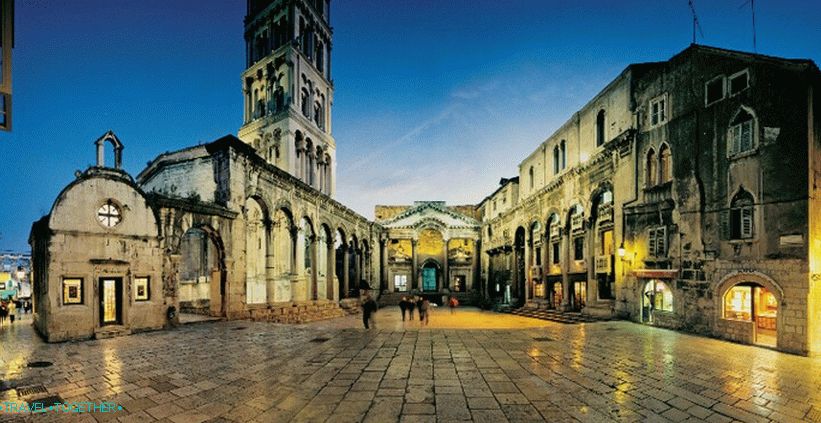 Perestil
Perestil
Perestil is one of the most important and beautiful parts of the palace. Diocletian. Originally it was the courtyard of the former villa the emperor. Now here is the area. One of its main features are columns. Most likely Diocletian is not here rested, and received guests and held events. On the west side of the courtyard he built three temples. The only one that survived to this day, this is the temple of Jupiter.
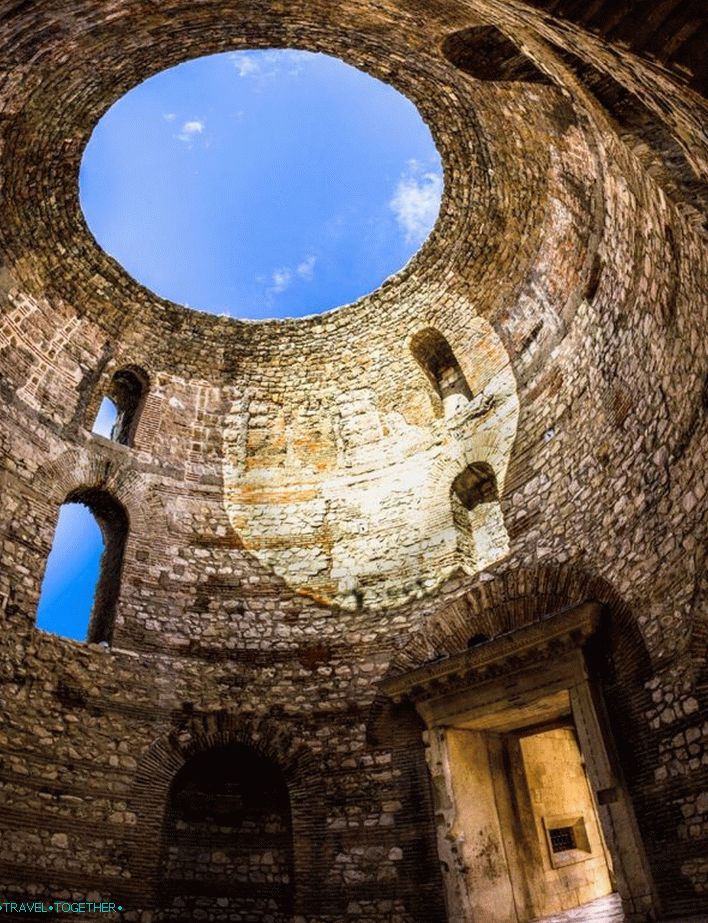 The lobby of the palace Diocletian
The lobby of the palace Diocletian
The lobby of Diocletian’s Palace is a well-preserved entrance to ancient palace. Interestingly, this is a rectangular structure. outside and inside has a round structure. Ancient bricks perfect fitted, and in the walls there are many niches in which before there were marble sculptures. Exactly unknown when collapsed the dome and what caused it to collapse. Now the dome is sky. Archaeologists and historians believe that the walls and floors of the lobby were lined with marble slabs and intricate mosaics, and the dome was covered impressive color frescoes.
 Split Cathedral
Split Cathedral
Split Cathedral (Church of St. Duim) – the most popular landmark Split. This ancient catholic temple was built in the 7th century in fact on the mausoleum of Diocletian (interestingly, that this Roman emperor considered Christians to be one of the threats of the empire and when it was organized cruel persecution) and is considered the oldest still the current cathedral in the world. Cathedral of sv. Duyma consists of two parts: a church dedicated to the Virgin Mary, and the bell tower dedicated to St. Duim (Douai), who was a bishop Salons (the Roman capital of Dalmatia) in the 3rd century. He was executed by order of Diocletian and is considered the patron saint of the city.
Since its construction, this ancient temple has hardly has changed. In the 11th century, they began to build a 60-meter bell tower. It is believed that its construction took 300 years. Cathedral built in Corinthian style (many columns are original Roman) and contains many ancient elements: hexagonal Romanesque stone the pulpit of the 13th century, the altar of Saint Douel of the 15th century, the altar of St. Anastasia of the same period.
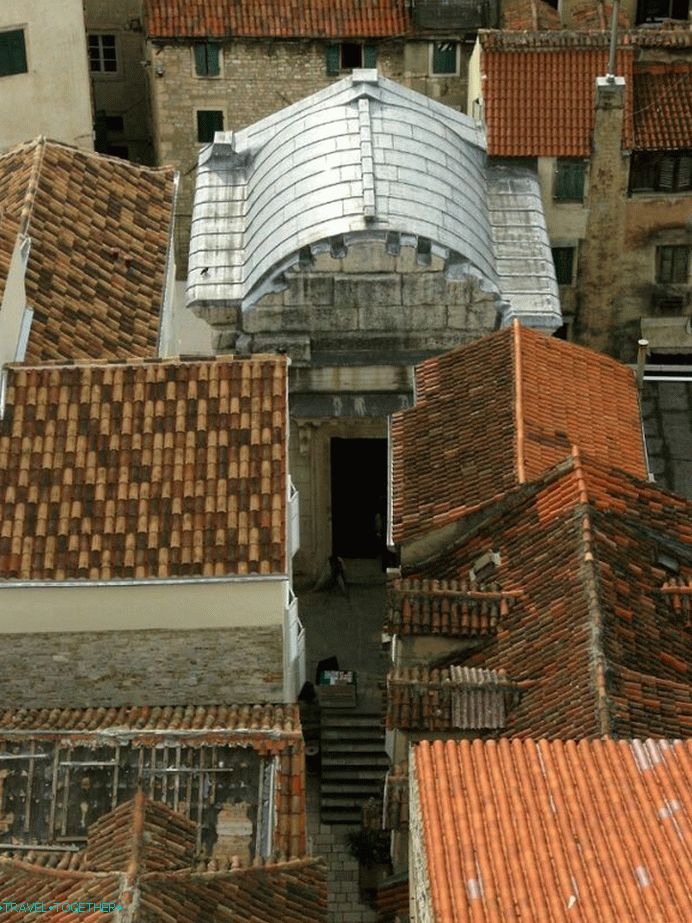 Baptistery (temple Jupiter)
Baptistery (temple Jupiter)
Baptistery – a small ancient structure near the square Peristyle. Is the only surviving Roman temple on territory of the palace of Diocletian. The temple was dedicated to the god Jupiter. Temple Jupiter was built between 295 and 305 AD. In the 6th century, he was converted into a Christian baptistery. Now it is an ancient building surrounds a maze of streets that make it easy to imagine how Split developed from Diocletian’s Palace.
It is believed that during the construction of the temple of Jupiter had a six-column portico, which later destroyed. Black Sphynx without a head was made during the Egyptian Pharaoh Thutmose III. Beheaded him Christians who considered the sphinx a pagan symbol. Interesting Baptistery features: beautiful vaulted ceiling, relief above a door of white limestone mined on the island of Brac, modern bronze statue of saint john the baptist created by one of The most famous Croatian sculptors of the 20th century, Ivan Mestrovichem (she stands where the statue of Jupiter used to stand) The oldest image of the Croatian king.
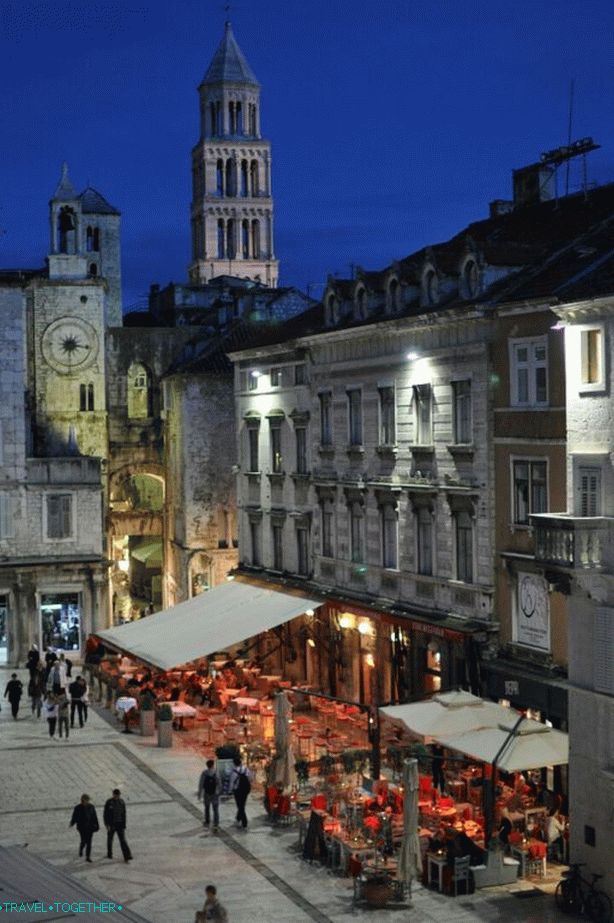 People’s Square
People’s Square
People’s Square – 15th century square in the historic center Split with many interesting buildings of the Renaissance, Gothic and Venetian style. The most beautiful buildings are Venetian-Gothic Cambrian Palace and the Town Hall in Renaissance style, which houses the ethnographic museum. The statue of Grgur Ninsky work by Meshtrovic who was a bishop in the 10th century and left an important mark on history Croatia For luck, you need to rub the big toe of the statue.
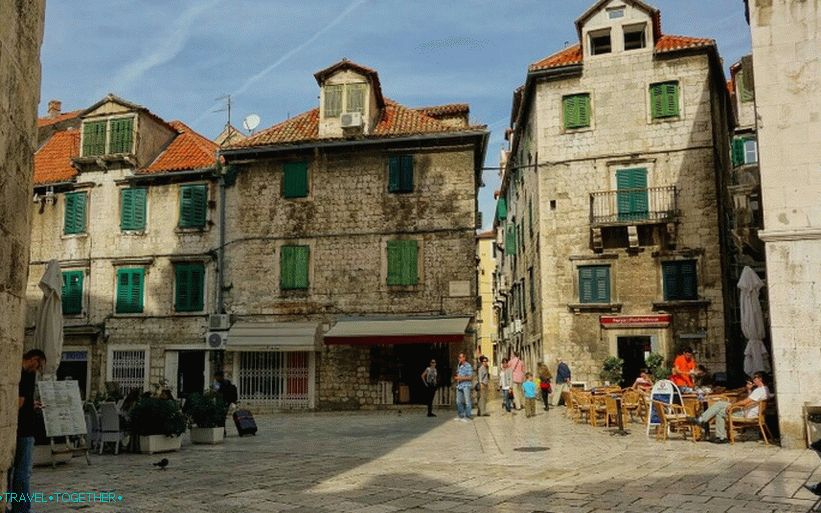 Fruit Square
Fruit Square
Fruit Square – considered one of the most beautiful areas not only in the city, but throughout the region thanks to the magnificent Baroque architecture of the buildings that surround it. Octagonal The Venetian tower is one of the oldest structures on the square. It was built in 1435 as part of the fortifications and served watchtower for more than three centuries. Installed on the square Statue of the father of Croatian literature – famous poet and humanist Marco Marulika. One of the most beautiful buildings of Split is Milesi Palace, built in a charming arched style.
Interestingly, the area is officially called Trg Brace Radic. But here before, farmers sold fruit and vegetables. Now here their no longer sell, but the name remains.
 Marjan Hill
Marjan Hill
Marjan Hill – the height in the west of Split is 174 meters high with beautiful view of the city. Almost the whole hill is occupied by a park, which is one of the favorite places of the inhabitants of the city. East of him is the church of sv. Nicholas, and on the south side – beautiful church of sv. Hieronymus
Video
Maps and guides
Map of the historical center Map of Split






